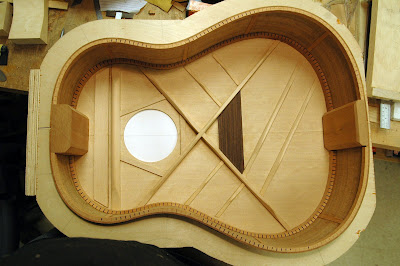Last week, I was about to start preparing my neck and realized I had a little problem. I was planning on cutting part of my archtop neck blank off and making the electric neck out of that, but I didn't actually check to see if it was even wide enough until last friday. It wasn't. If I wanted to use it, I would have to add wings to the headstock, something that really just doesn't work out with flamed maple unless you are adding a headstock laminate or putting an opaque finish on it. Being that neither of these options were acceptable to me, I decided to rush order a strat sized neck blank from LMI, and was extremely happy that I did. The flame on this neck blank is some of the sweetest I have seen. I know it sounds silly, but that was just the thing I needed to put me in the mood to work hard today and I got quite a bit done.
First of all, I had to square up the blank and thickness plane it down to the finished thickness of 3/4". Once this was done, I laid the headstock template on the blank and drew a centerline on the neck according to the center line of the headstock template. Then, the neck was cut down to length where it meets the body and the trussrod slot was routed.
Here is a shot of the truss rod slot with the trussrod in place:

After the trussrod was in, I cut off and shaped the end of the fingerboard and cut the back slot for the nut shelf, being that it is a fender style nut where the nut actually sits in a slot in the fingerboard as opposed to the nut shelf being on the neck behind the fingerboard. After installing some side dots in the fingerboard, I located and pinned the fingerboard before gluing it on.
Here is the neck blank with the fingerboard glued on:

While the fingerboard was clamped, I flush routed the top to the body and did a little spindle sanding around the curves to get everything nice and smooth. I still had some time before un-clamping so I got some more work in on shaping the acoustic neck and it is really close to being ready to be sanded for finishing.
I still haven't decided how I am going to finish the electric, but it will have something to do with reds and oranges. I really like the figure in the top, so it will most likely be only lightly toned so as not to detract from it's natural beauty, but there are definitely a lot of options with the neck and the back/side area of the body.
Here's a photo of the under construction neck with the body to get an idea of how they will look toghether:
 Subtract all the wood that isn't part of the guitar, add some gold fretwire, gold tuners, gold bridge, black pickups, some pots, spray a finish, and it's a guitar! Easy enough, right? Well, it is getting closer to being a shredding machine...
Subtract all the wood that isn't part of the guitar, add some gold fretwire, gold tuners, gold bridge, black pickups, some pots, spray a finish, and it's a guitar! Easy enough, right? Well, it is getting closer to being a shredding machine...





































